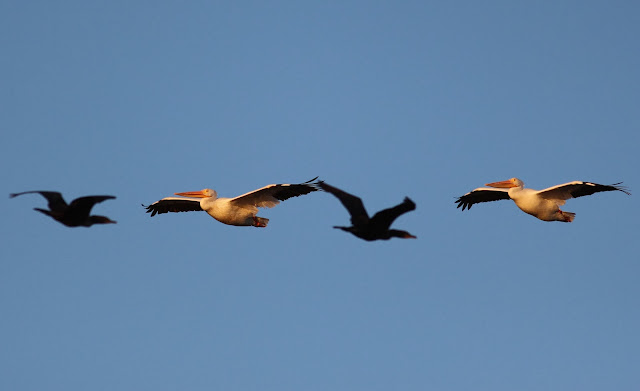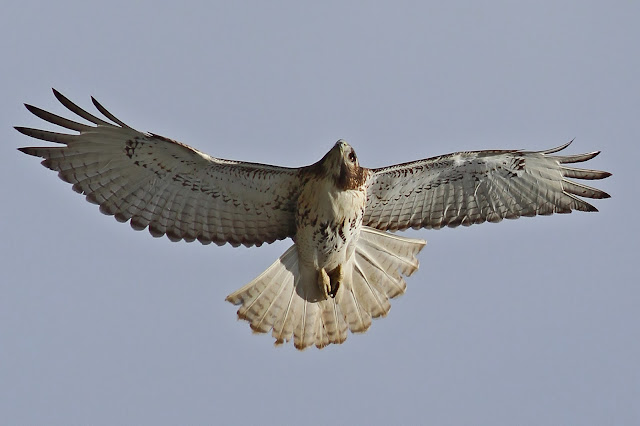Trinity River Project Chain of Wetlands — American White Pelicans and Waterfowl On The Fly
 |
| American White Pelican at the Trinity River Wetland Cells, Dallas Texas, November 2013 |
As the days grow shorter and the temperature begins to drop the chain of wetland cells in South Dallas often host a random mix of feathered visitors from afar. The Trinity River makes a gradual bend here, a slow graceful bow as it picks up the mouth of White Rock Creek and several unnamed tributary creeks that drain the old communities of Joppa, Pemberton Hill and Fruitdale.
The mouths of these tributaries harbor ancient stands of trees for which no man ever saw any use. As a result those trees now tower far above the traditional second growth woods of ash and pioneer species that dominate much of what is called the Great Trinity Forest. Roosted by Wood Storks in the summers and Cormorants in the winter, these trees serve a vital function as wildlife habitat.
 |
| Roseate Spoonbills and Avocets, Little Lemmon Lake, November 2013 |
The steep channel of the Trinity and the muddy banks here are a mere sideshow attraction compared to the wildlife using the wetlands above.
November is a transition month for wildlife in the Great Trinity Forest. The land based animals shed their noctural activity and can often be seen in broad daylight. The whitetail deer enter their customary fall rut, the feral pigs openly forage under the pecans and walnut trees along the river.
Most interesting though is the changing of the guard with the bird life on the river. Even if you are not ornthologically inclined, the random birds down here can often combine to stump novice and schooled scholar alike. The mix of Roseate Spoonbills from Central America with American White Pelicans from the Grand Tetons in the same pond together really shows Dallas as a brief crossroads of bird migration.
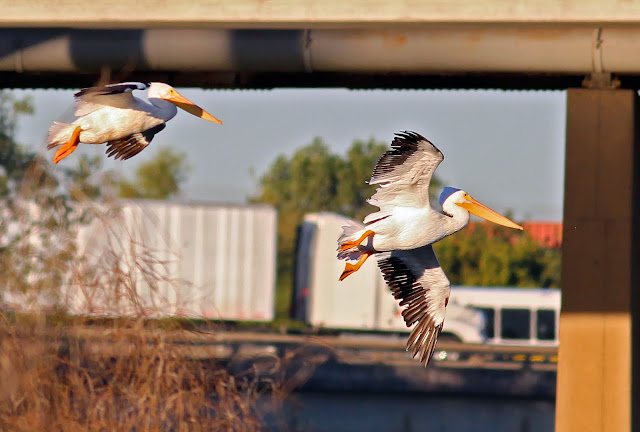 |
| Pelicans landing at the base of Old Central Expressway Wetland Cell E; I-45 traffic seen beyond |
It was a cold summer for the Northern Plains in the United States this year. Those cold temperatures delayed the nesting season of northern ducks by many weeks according to the experts. As a result, eggs were laid later than normal and duckings were slow on the calendar to mature. As of early November many of the over-wintering birds customary to the Chain of Wetlands are still filtering through the Great Plains.
 |
| Male Northern Shoveler in non-breeding plumage November 2013 |
In years past, the majority of male Northern Shovelers would already be sporting their robust breeding plumage. This year very few have their colors grown in. Nor are they in North Texas to any degree.
 |
| Pre-dawn light at the Chain of Wetlands, Freedman’s town of Joppa to the left, Trinity River to the right. Cell F seen in photo |
Dallas Floodway Extension and the Chain of Wetlands
The Chain of Wetlands is a $120 million dollar project funded with roughly $25 million in funds from the 1998 Trinity River Project bonds and $90 million dollars in federal funding.
The Lower Chain of Wetlands consist of ponds D, E, F and G. The ponds were constructed downstream of the Central Wastewater Treatment Plant and stretch from roughly I-45 to Loop 12.
E, F and G are shown at left with yellow lines representing dirt roads that criss-cross the cells.
In theory the wetlands are designed to reduce water surface height within the river bottom by adding over banking capacity along the west side of the Trinity River from the north end of the Cadillac Heights neighborhood to Loop 12.
Access to the Wetland Cells is easy. One can park at the Loop 12 Boat Ramp lot on Great Trinity Forest Way. Then walk up the embankment of the divided road, entering the Wetland Cells via the old Sleepy Hollow Country Club parking lot. Currently the gate is broken at the Sleepy Hollow entrance, the weld failed on the padlocking portion of the gate. Speaking with the city, they decided to allow access to the Wetlands via the large parking lot. Naturally, without barricades to prevent further access it has become a 4×4 offroad venue of sorts.
Many of the vehicles over the course of a few high speeds laps start as brand new vehicles and are quickly reduced to piles of junk, suggesting they are stolen. I could imagine very few owners of new GMC Yukons would drive 40-60mph down dirt roads and taking liberties with sending it airborne. Watch your back if you are on foot or on a mountain bike out there as the vehicles are not expecting foot traffic.
The other parking option is in the Freedman’s Town of Joppa, where Fellows Lane dead-ends at a bar gate. Like the bar gate near Loop 12(Great Trinity Forest Way) this entrance has also been undermined to some degree. Though the gate is locked, one can navigate through the vacant lot to the west and then into the Wetland Cell 4×4 roads. This footprint of vacant lots will eventually become a gateway park for Joppa into the Wetland Cells.
Best time of day to see birds, universally, is at dawn. If you can get down into their habitat before they awake for the day, the chances of having some quality time with birds dramatically increases. The 4×4 vehicle antics drive the birds away later in the day, morning is the best time to see them here.
 |
| Mallards at Wetland Cell G |
Blessed with frequent fall rains and prolonged muddy conditions, travel through the chain of wetlands impaired vehicle access which allowed the birds in late October and early November to really load up in the more secluded areas of Cells E and F.
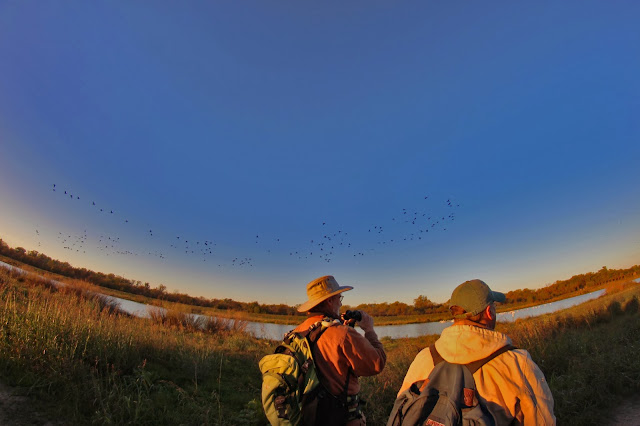 |
| Master Naturalist Bill Holston and Scott Hudson watching hundreds of Cormorants fly over Cell F |
Some of the most inaccessible areas in the Chain of Wetlands feature towering cottonwoods that line a stretch of river near the mouth of White Rock Creek. In the autumn, hundreds of migrating Cormorants roost in the trees there. If one gets down into the wetland cells at dawn, you can watch the spectacle of them leaving for the day en masse.
In the early morning the area is quiet enough to hear the beating wings of a hundred Cormorants over head, a methodical beating unlike anything else. Many visitors to White Rock Lake a few miles to the north can see something similar but the noise of the birds is all but drowned by the noise of the city.
 |
| American White Pelicans in Cell F |
 The stars of the show on such a crisp morning are of course the pelicans. Seen above preening and preparing for a morning of fishing. The social birds are very well organized and use large family groups and pods to form feeding parties.
The stars of the show on such a crisp morning are of course the pelicans. Seen above preening and preparing for a morning of fishing. The social birds are very well organized and use large family groups and pods to form feeding parties.
From a great distance one can view the large birds. No need to crowd them as they afford descent sighting at long range.
The best approach to watch feeding birds like this, is no approach at all. Find a good spot with the sun at your back and let the birds come to you.
American White Pelicans in the Chain of Wetlands
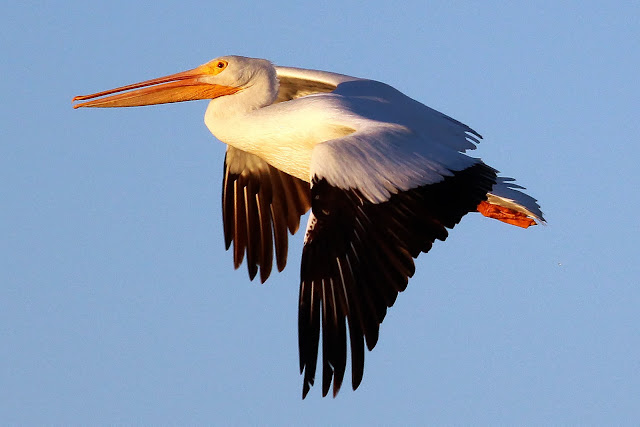 |
| American White Pelican |
The American White Pelican Pelecanus erythrorhynchos is one of the largest birds in North America. It is second only to the Trumpeter Swan in overall height and second only to the California Condor in wingspan. Some of these pelicans have wingspans of 9 feet making them battleship size birds of the sky that rapidly fill a camera viewfinder.
American White Pelicans fly gracefully, spreading their wings and sliding onto the water on their feet as they land. Flight is usually in linear formations or forming a “V.” They flap and glide and may soar on days when they can take advantage of updrafts.
American white pelicans don’t dive, as do their relatives, brown pelicans, but they are strong swimmers and have subcutaneous air sacs in the region of their breast that give them buoyancy. They are gregarious birds, always found roosting, nesting, or foraging in groups.
Many would assume that White Pelicans are birds of the saltwater and make some kind of wayward migration inland in the fall. The truth is that these birds in Dallas might never see the ocean in their lifetime. They spend their summers in Canada and the Rocky Mountains.
 |
| Wetland Cell F |
On occasion, one or two birds will show up to North Texas banded. Using a good spotting scope or long camera lens one can read the numbers off the band and look it up in an online database. Those bands show that the Dallas pelicans for the most part, spend their summers in an area bounded by Yellowstone National Park in Montana, the Grand Tetons of Wyoming and lakes in Eastern Idaho.
In the northern part of their range they feast on trout for the summer, making quick work of fish in shoal banks and lakes. Some consider the pelicans numbers as unsustainable to the trout fishery in that neck of the woods and are looking at options to reduce their population.
 |
| Breakfast bell is ringing, time to eat |
The birds nest and raise young on these mountain lakes and rivers during the summer and as harbingers of fall usually make it down to North Texas by October 15th. In 2013, the first noted arrival of a pelican in Dallas was September 6, 2013 at White Rock Lake with the majority following a month later.
 |
| White Pelican at Wetland Cell E |
The majority of the overwintering pelicans in Dallas move around from waterbody to waterbody. They might spend the night in the Wetland Cells, spend the afternoon at White Rock Lake and then depart for Lake Ray Hubbard towards sunset. There have been Audubon Society members who have been able to follow the movements of the larger flocks from one lake to the other with great success.
 |
| Wetland Cell E loaded with pelicans, cormorants and ducks. In the background is Old Central Expressway and beyond I-45 |
If they are there, one of the best spots to view pelicans is Wetland Cell E. The subdivided cell only a few acres in size features a prominent peninsula that juts from the east bank.
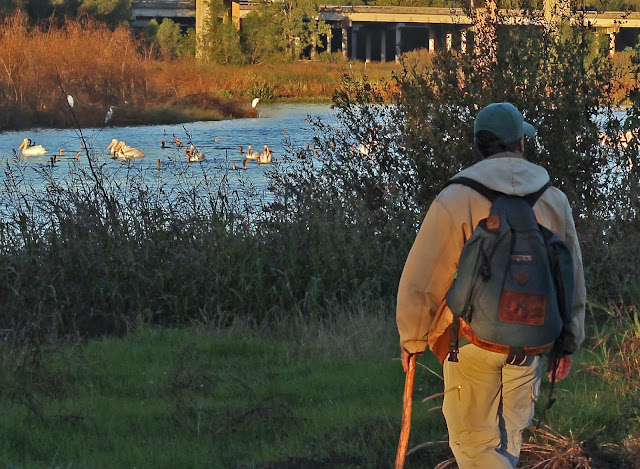 |
| Bill Holston quietly approaching the shoreline as pelicans work together to drive fish towards the shore |
The pelicans seen above work in picket lines, coordinated, driving fish in front of them towards the shore. Cormorants follow close behind, diving as they go to pick up stragglers.
The driving of not just baitfish but even larger game fish like bass and catfish often reaches a fevered pitch as the pelicans trap the quarry near the shoreline.
Seen at left, a pod of pelicans move in to the brush gulping water as the drive. Unlike many birds, the pelicans are not wholly selective of what they are fishing for. Their pouches filter through many gallons of water per minute, effective in the siphoning off of water leaving only fish behind.
 |
| Gadwall Ducks, White Pelicans and Cormorants headed right for us at Cell E |
 |
| A cormorant at Cell E has caught a fish almost too large to swallow and attracted a host of jealous onlookers |
Some of the fish caught are surprising in size. Looking through the photos shot at Cell E, a number of large shad, bass and catfish were caught by the cormorants in addition to crawfish from time to time.
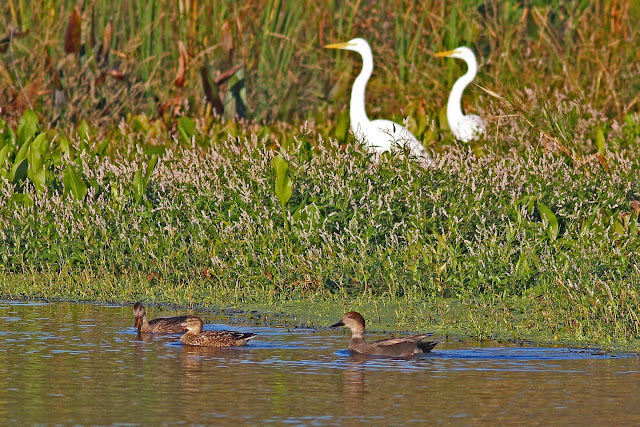 |
| Female Gadwall, Female Northern Shoveler a Male Gadwall, Great Egrets await patiently in the background Cell E |
The water in the Chain of Wetlands is too deep for wading birds. The stair stepped submarine topography of the cells is designed to move water, provide flood protection and absorb nitrates and phosphates from the effluent discharge used to fill the chain of lakes. The wading birds and their habitat don’t fit into the plans so birds like the Great Egrets seen above must get creative in foraging for food.
 |
| Great Egret making a succesful plunge for a sunfish in the Wetland Cells |
I imagine the birds will just need to wait for a dozen or so solid flooding events to overtop the project here that will gradually over time silt in some of these areas creating a vast archipelago of dotted habitat for these birds.
 |
| Near the Fellows Lane entrance looking south towards Cells F and G |
Many of the duck species in the coming winter months will gravitate towards the east side of Cell G where special aquatic food plots are growing for them. The peninsula and fractured nature of the cell provide cover for the birds and habitat for the winter months ahead.
In the coming year, cells A, B and C will be constructed just south of the Standing Wave and near Cadillac Heights.
 |
| Two male Gadwalls and female Gadwall (lower bird with orange bill) |
Unlike White Rock Lake, many of the birds are not here on a day-to-day basis. They use the chain here as a way station and a revolving habitat where they spend part of their time. It attracts some species rarely seen other places around Dallas given the southeastern proximity to the edges of some flyways.
If you are interested in seeing the wetland cells and learning more one of the best ways to safely experience the area is to join the Trinity River Bird Count. The next one just happens to be November 16, 2013 at the Fellows Lane entrance to the Wetland Cells. More information can be found at the Trinity River Bid Count Website here:
http://trinityriver.audubon.org/trinity-bird-count
And the calendar
http://www.trinitybirdcount.com/calendar.html
John Bunker Sands Wetlands a little further down US 175 offers a similar experience with a unique set of exhibits that describe wetland cells, birds and wildlife. They are open the 1st and 3rd Saturdays to the public. If you have not been you should go. More information on their website here:
http://www.wetlandcenter.com/


